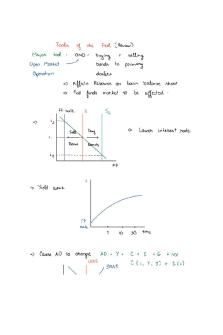Chapter 22 The Monetary Policy and Aggregate Demand Curves PDF

| Title | Chapter 22 The Monetary Policy and Aggregate Demand Curves |
|---|---|
| Author | Sócrates Álvarez |
| Course | Money Banking & Government Policy |
| Institution | McGill University |
| Pages | 3 |
| File Size | 288.9 KB |
| File Type | |
| Total Downloads | 7 |
| Total Views | 174 |
Summary
Download Chapter 22 The Monetary Policy and Aggregate Demand Curves PDF
Description
Chapter 22: The Monetary Policy and Aggregate Demand Curves ● The Bank of Canada and Monetary Policy ○ The Bank of Canada controls the overnight interest rate by varying the reserves it provides to the banking system. ■ More reserves → more money to lend to each other → overnight interest falls ○ NOTE that overnight interest is a nominal interest rate. ■ Real interest rate is the one that affects net exports and business spending ○ Does changing overnight real interest rate has an effect on real interest rate? YES ■ Remember
r=i−π
e
, where r is real interest rate and i is the nominal interest rate,
and we know prices are sticky so in the short run a change in the overnight interest will not have an immediate effect on inflation and expected inflation. That said, ● (In the short run) When the BoC lowers the overnight interest rate, real interest rates fall; when BoC raises the overnight interest rate, real interest rates rise. ● The monetary policy(MP) curve ○
The monetary policy curve indicates the relationship between the real interest rate set by the central bank and the inflation rate. ■
r=r + λ π r
●
where is the autonomous component of the real interest rate set by the monetary
authority. ●
λ is the responsiveness of the real interest rate to the inflation rate
● The Taylor Principle: Why the monetary policy curve has an upward slope ○ To stabilize inflation, monetary policymakers tend to follow the Taylor principle. They raise nominal rates by more than any rise in expected inflation so that real interest rates will rise when there is a rise in inflation, as illustrated by the MP curve ○ IF THEY DON’T, like they decrease interest rates when inflation rises inflation would go out of control, it would go this π ↑ → r ↓ →Y ↑ → π ↑→ r ↓→ Y ↑ → π ↑ ● Shifts in the MP curve ○ Some lingo you need to know: ■ “The Bank has tighten monetary policy” ← The Bank has increased real interest rates ■ “The Bank has easen monetary policy” ← The Bank has decreased real interest rates ○ A shift occurs when the Bank changes the autonomous part of the MP curve ■ For example, to lower inflation, they could increase r by one percentage point and so raise the real interest rate at any given interest rate, a move that we will refer to as an autonomous tightening of monetary policy. ■ On the contrary if the economy is going into a recession, monetary policymakers will
want to lower real interest rates at any given inflation rate, an autonomous easing of monetary policy in order to stimulate the economy and to prevent inflation from falling.
● Movements along versus shifts in the MP curve ○ Is a movement if is just an automatic response to a change in inflation, the Bank following taylor rule. ● The aggregate demand curve ○ The aggregate demand curve is the relationship between the inflation rate and the aggregate output when the goods market is in the equilibrium.
● Shifts in the aggregate demand curve ○ Same six as the IS curve but one extra ■ An autonomous tightening of monetary policy –that is, a rise in the real interest rate at
any given inflation rate – shifts the aggregate demand curve to the left, Conversely, an autonomous easing of monetary policy shifts the aggregate demand curve to the right....
Similar Free PDFs

Chapter 16 Monetary Policy
- 3 Pages

Chapter-5 - Monetary policy
- 11 Pages

Hotel Industry Demand Curves
- 14 Pages
Popular Institutions
- Tinajero National High School - Annex
- Politeknik Caltex Riau
- Yokohama City University
- SGT University
- University of Al-Qadisiyah
- Divine Word College of Vigan
- Techniek College Rotterdam
- Universidade de Santiago
- Universiti Teknologi MARA Cawangan Johor Kampus Pasir Gudang
- Poltekkes Kemenkes Yogyakarta
- Baguio City National High School
- Colegio san marcos
- preparatoria uno
- Centro de Bachillerato Tecnológico Industrial y de Servicios No. 107
- Dalian Maritime University
- Quang Trung Secondary School
- Colegio Tecnológico en Informática
- Corporación Regional de Educación Superior
- Grupo CEDVA
- Dar Al Uloom University
- Centro de Estudios Preuniversitarios de la Universidad Nacional de Ingeniería
- 上智大学
- Aakash International School, Nuna Majara
- San Felipe Neri Catholic School
- Kang Chiao International School - New Taipei City
- Misamis Occidental National High School
- Institución Educativa Escuela Normal Juan Ladrilleros
- Kolehiyo ng Pantukan
- Batanes State College
- Instituto Continental
- Sekolah Menengah Kejuruan Kesehatan Kaltara (Tarakan)
- Colegio de La Inmaculada Concepcion - Cebu












